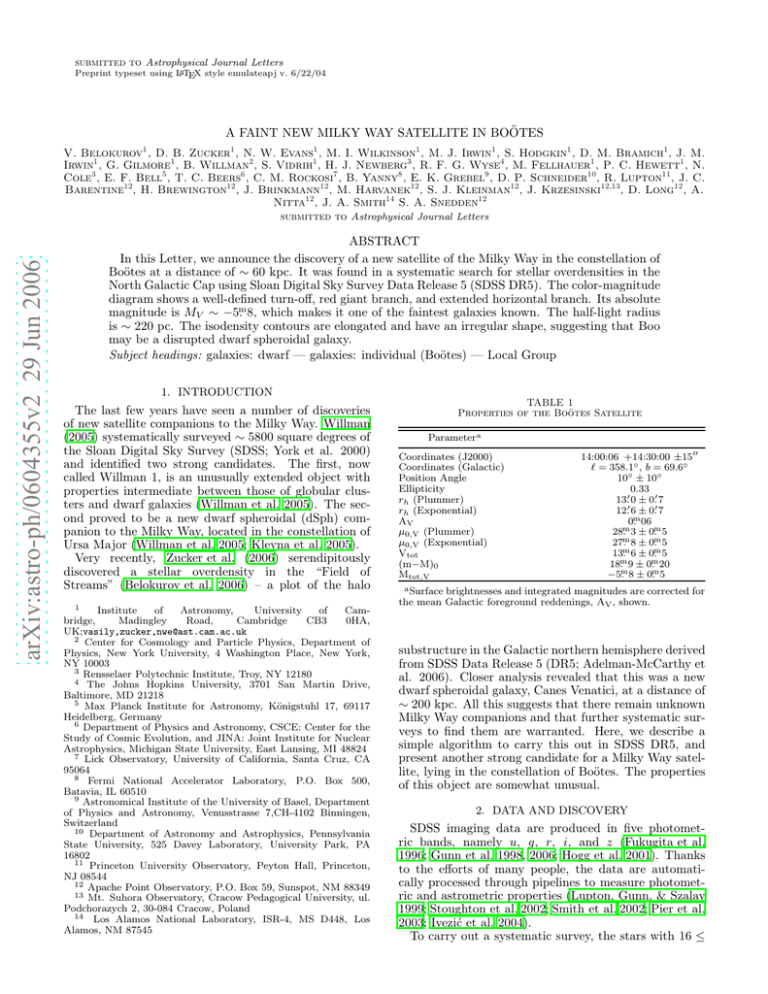A FAINT NEW MILKY WAY SATELLITE IN BO ¨ OTES
advertisement

submitted to Astrophysical Journal Letters Preprint typeset using LATEX style emulateapj v. 6/22/04 A FAINT NEW MILKY WAY SATELLITE IN BOÖTES 1 V. Belokurov , D. B. Zucker1 , N. W. Evans1 , M. I. Wilkinson1 , M. J. Irwin1 , S. Hodgkin1 , D. M. Bramich1 , J. M. Irwin1 , G. Gilmore1 , B. Willman2 , S. Vidrih1 , H. J. Newberg3 , R. F. G. Wyse4 , M. Fellhauer1 , P. C. Hewett1 , N. Cole3 , E. F. Bell5 , T. C. Beers6 , C. M. Rockosi7 , B. Yanny8 , E. K. Grebel9 , D. P. Schneider10 , R. Lupton11 , J. C. Barentine12, H. Brewington12 , J. Brinkmann12 , M. Harvanek12 , S. J. Kleinman12 , J. Krzesinski12,13, D. Long12 , A. Nitta12 , J. A. Smith14 S. A. Snedden12 arXiv:astro-ph/0604355v2 29 Jun 2006 submitted to Astrophysical Journal Letters ABSTRACT In this Letter, we announce the discovery of a new satellite of the Milky Way in the constellation of Boötes at a distance of ∼ 60 kpc. It was found in a systematic search for stellar overdensities in the North Galactic Cap using Sloan Digital Sky Survey Data Release 5 (SDSS DR5). The color-magnitude diagram shows a well-defined turn-off, red giant branch, and extended horizontal branch. Its absolute magnitude is MV ∼ −5.m 8, which makes it one of the faintest galaxies known. The half-light radius is ∼ 220 pc. The isodensity contours are elongated and have an irregular shape, suggesting that Boo may be a disrupted dwarf spheroidal galaxy. Subject headings: galaxies: dwarf — galaxies: individual (Boötes) — Local Group 1. INTRODUCTION The last few years have seen a number of discoveries of new satellite companions to the Milky Way. Willman (2005) systematically surveyed ∼ 5800 square degrees of the Sloan Digital Sky Survey (SDSS; York et al. 2000) and identified two strong candidates. The first, now called Willman 1, is an unusually extended object with properties intermediate between those of globular clusters and dwarf galaxies (Willman et al. 2005). The second proved to be a new dwarf spheroidal (dSph) companion to the Milky Way, located in the constellation of Ursa Major (Willman et al. 2005; Kleyna et al. 2005). Very recently, Zucker et al. (2006) serendipitously discovered a stellar overdensity in the “Field of Streams” (Belokurov et al. 2006) – a plot of the halo 1 Institute of Astronomy, University of Cambridge, Madingley Road, Cambridge CB3 0HA, UK;vasily,zucker,nwe@ast.cam.ac.uk 2 Center for Cosmology and Particle Physics, Department of Physics, New York University, 4 Washington Place, New York, NY 10003 3 Rensselaer Polytechnic Institute, Troy, NY 12180 4 The Johns Hopkins University, 3701 San Martin Drive, Baltimore, MD 21218 5 Max Planck Institute for Astronomy, Königstuhl 17, 69117 Heidelberg, Germany 6 Department of Physics and Astronomy, CSCE: Center for the Study of Cosmic Evolution, and JINA: Joint Institute for Nuclear Astrophysics, Michigan State University, East Lansing, MI 48824 7 Lick Observatory, University of California, Santa Cruz, CA 95064 8 Fermi National Accelerator Laboratory, P.O. Box 500, Batavia, IL 60510 9 Astronomical Institute of the University of Basel, Department of Physics and Astronomy, Venusstrasse 7,CH-4102 Binningen, Switzerland 10 Department of Astronomy and Astrophysics, Pennsylvania State University, 525 Davey Laboratory, University Park, PA 16802 11 Princeton University Observatory, Peyton Hall, Princeton, NJ 08544 12 Apache Point Observatory, P.O. Box 59, Sunspot, NM 88349 13 Mt. Suhora Observatory, Cracow Pedagogical University, ul. Podchorazych 2, 30-084 Cracow, Poland 14 Los Alamos National Laboratory, ISR-4, MS D448, Los Alamos, NM 87545 TABLE 1 Properties of the Boötes Satellite Parametera Coordinates (J2000) Coordinates (Galactic) Position Angle Ellipticity rh (Plummer) rh (Exponential) AV µ0,V (Plummer) µ0,V (Exponential) Vtot (m−M)0 Mtot,V 14:00:06 +14:30:00 ±15′′ ℓ = 358.1◦ , b = 69.6◦ 10◦ ± 10◦ 0.33 13.′ 0 ± 0.′ 7 ′ 12. 6 ± 0.′ 7 0.m 06 28.m 3 ± 0.m 5 27.m 8 ± 0.m 5 13.m 6 ± 0.m 5 18.m 9 ± 0.m 20 −5.m 8 ± 0.m 5 a Surface brightnesses and integrated magnitudes are corrected for the mean Galactic foreground reddenings, AV , shown. substructure in the Galactic northern hemisphere derived from SDSS Data Release 5 (DR5; Adelman-McCarthy et al. 2006). Closer analysis revealed that this was a new dwarf spheroidal galaxy, Canes Venatici, at a distance of ∼ 200 kpc. All this suggests that there remain unknown Milky Way companions and that further systematic surveys to find them are warranted. Here, we describe a simple algorithm to carry this out in SDSS DR5, and present another strong candidate for a Milky Way satellite, lying in the constellation of Boötes. The properties of this object are somewhat unusual. 2. DATA AND DISCOVERY SDSS imaging data are produced in five photometric bands, namely u, g, r, i, and z (Fukugita et al. 1996; Gunn et al. 1998, 2006; Hogg et al. 2001). Thanks to the efforts of many people, the data are automatically processed through pipelines to measure photometric and astrometric properties (Lupton, Gunn, & Szalay 1999; Stoughton et al. 2002; Smith et al. 2002; Pier et al. 2003; Ivezić et al. 2004). To carry out a systematic survey, the stars with 16 ≤ 2 Belokurov et al. Fig. 1.— The Boötes Satellite: Upper left: Combined SDSS g, r, i images of a 1◦ × 1◦ field centered on the overdensity. ∆α and ∆δ are the relative offsets in right ascension and declination, measured in arcdegrees. The dotted circle indicates a radius of 0.15◦ . Upper middle: The spatial distribution of all objects classified as stars in the same area. Upper right: Binned spatial density of all stellar objects. The inner dotted circle marks a radius of 0.15◦ and encloses the same area as the two outer circles, which have a radius of 0.4◦ and 0.43◦ respectively. Bins are 0.033◦ × 0.033◦ , smoothed with a Gaussian with a FWHM of 0.1◦ . Lower left: CMD of all stellar objects within the inner 0.15◦ radius circle. There is a clear red giant and horizontal branch, even without removal of field contamination. Lower middle: Control CMD, showing all stellar objects in the annulus between 0.4◦ and 0.45◦ of the center. Lower right: A color-magnitude density plot (Hess diagram), showing the inner CMD minus the control CMD, normalized to the number of stars in each CMD. A mask is shown around the satellite’s sequence. r ≤ 22 are first binned into 10′ × 10′ regions in right ascension and declination. Then, a running window of size 1◦ × 1◦ is used to compute the background. All bins that are more than 3σ away from the background are selected. Known satellite galaxies and globular clusters are removed using the list of van den Bergh (2000a). Visual inspection is used to discard a few obvious contaminants, such as resolved stellar associations in background galaxies. All the candidates are ranked according to the signal-to-noise. The two strongest candidates that remain are the Canes Venatici dSph (Zucker et al. 2006) and the object studied in this Letter, which is named Boo after the constellation of Boötes in which it lies. The upper left panel of Figure 1 shows a grayscale SDSS image of the sky centered on Boo. There is no obvious object. However, on plotting the density of all objects classified by the SDSS pipeline as stars, a curiouslyshaped overdensity is readily visible (upper middle and right panels). Plotting these stars in a color-magnitude diagram (CMD) reveals a clear red giant branch and horizontal branch (lower panels). This evidence of a localized overdensity of stars with a distinct color-magnitude diagram suggests that this is a new satellite – possibly a dwarf galaxy. 3. PHYSICAL PROPERTIES AND STELLAR POPULATION Follow-up observations of Boo were made on 25 Feb 2006 and 7 Mar 2006 (UT) with the 4m Blanco telescope at Cerro Tololo Inter-American Observatory in Chile, using the MOSAIC-II CCD camera. This comprises 8 2k×4k pixel SITe CDDs, with a field of view 36×36 arcminutes and a scale of 0.27 arcseconds per pixel at the image centre. Boo was observed in the g and i bands, with exposure times of 3×360s in each filter on the first night and 3×600s in each filter on the second night, for a total exposure of 2880s in each filter. The telescope was offset (≈30 arcsecond) between exposures. Data were processed in Cambridge using a general purpose pipeline for processing wide-field optical CCD data (Irwin & Lewis 2001). Images were de-biased and trimmed, and then flatfielded and gain-corrected to a common internal system using clipped median stacks of nightly twilight flats. The i−band images, which suffer from an additive fringing component, were also corrected using a fringe frame computed from a series of long i−band exposures taken during the night. For each image frame, an object catalogue was generated using the object detection and parameterisation procedure discussed in Irwin et al. (2004). Astrometric New Satellite in Boötes 3 Fig. 2.— Color-magnitude diagram of Boo derived from CTIO data. Overplotted is the ridge-line for the old, metal-poor globular cluster M92. The dashed lines are used to select stars belonging to the main sequence, giant branch and horizontal branch of the satellite. For each magnitude bin, the mean color error is shown on the left-hand side. calibration of the invididual frames is based on a simple Zenithal polynomical model derived from linear fits between catalogue pixel-based coordinates and standard astrometric stars derived from on-line APM plate catalogues. The astrometric solution was used to register the frames prior to creating a deep stacked image in each passband. Object catalogues were created from these stellar images and objects morphologically classified as stellar or non-stellar (or noise-like). The detected objects in each passband were merged by positional coincidence (within 1′′ ) to form a g,i combined catalogue. This catalogue was photometrically calibrated onto the SDSS system using the overlap with the SDSS catalogues. Figure 2 shows a CMD constructed from the CTIO data. The fiducial ridgeline of the metal-poor globular cluster M92 ([Fe/H] ∼ −2.3) from Clem (2005) is overplotted on the CMD. The horizontal branch is wellmatched, though Boo’s giant branch and MSTO are slightly blueward of the M92 isochrone. This is consistent with Boo being somewhat younger and slightly more metal-poor than M92. Note in particular the narrowness of the giant branch of the CMD in Figure 2, as evidenced by the mean color error bar shown on the lefthand side. This is characteristic of single epoch stellar populations, which are normally associated with globular clusters. However, although most dSph galaxies show evidence of multiple stellar populations, a few are known whose CMDs possess narrow red giant branches, such as Ursa Minor and Carina (van den Bergh 2000b). In both cases, the narrow red giant branch is nonetheless consistent with a number of epochs of star formation (see e.g., Shetrone et al. 2001; Koch et al. 2006). From the fact that the horizontal branch of M92 provides a good fit, we can estimate the distance of Boo. The distance modulus is (m − M )0 ∼ 18.9 ± 0.2, corresponding to ∼ 60 ± 6 kpc, where the error bar includes the uncertainty based on differences in stellar populations of Boo and M92, as Fig. 3.— Morphology of Boo: Upper: The spatial distribution of SDSS stars selected from CMD regions marked with dashed lines in Fig. 1. Lower: A contour plot of the spatial distribution of Boo’s stars; candidate blue horizontal branch stars and blue stragglers (from the boxes in the CMD) are overplotted with black dots and open circles. The contours are 1.5, 3, 5, 7, 10 and 13σ above the background level. The direction of increasing Galactic latitude is marked by an arrow. well as the uncertainty in the distance of M92 . Note also that there is a prominent clump in the CMD below the horizontal branch, where Boo’s blue straggler population resides. Even though the CMD resembles that of a globular cluster, this is emphatically not the case for the object’s morphology and size. To select candidate stars, we use the boundaries marked by the dashed lines on the CMD, which wrap around the satellite sequence. SDSS data are used here as the CTIO data are largely confined to the inner parts of Boo. The locations of SDSS stars with r < 23 lying within the boundaries are plotted in the top 4 Belokurov et al. Fig. 4.— Profile of Boo, showing the stellar density in elliptical annuli as a function of mean radius. The left panel is logarithmic in both axes, and the right panel is linear in radius. The overplotted lines are fitted Plummer (solid) and exponential (dashed) profiles. Fig. 5.— Normalized luminosity functions of the inner (solid) and outer (dashed) parts of Boo, constructed with the CTIO data. The main sequence turn-off is indicated by the arrow. panel of Fig. 3. These objects are binned into 30 × 30 bins, each 0.033◦ × 0.033◦, and smoothed with a Gaussian with FWHM of 0.067◦ to yield the plot in the lower panel. The density contours, representing 1.5, 3, 5, 7, 10 and 13σ above the background level, are elongated and irregular – more so than even the most irregular of the Galactic dSphs, Ursa Minor (see e.g., Palma et al. 2003). The black dots are candidate blue horizontal branch stars and open circles are blue stragglers. The spatial distribution of both populations is roughly consistent with the underlying density contours and shows the same tail-like extensions. There are hints that Boo could be a much larger object, as the blue horizontal branch and straggler population extend beyond the outermost contours. To estimate the properties listed in Table 1, we use the SDSS data shown in Figure 3 to derive the centroid from the density-weighted first moment of the distribution, and the average ellipticity and position angle using the three density-weighted second moments (e.g., Stobie 1980). The radial profile shown in Figure 4 is derived by computing the average density within elliptical annuli after first subtracting a constant asymptotic background level (0.2 arcminute−2 ) reached at large radii. We then fit the radial profile with standard Plummer and exponential laws (Figure 4, see also Irwin & Hatzidimitriou 1995). The best-fitting position angle, ellipticity and half-light radius are listed in Table 1. At a distance of ∼ 60 kpc, the half-light radius of 13.′ 0 corresponds to ∼ 220 pc. This is the typical scale length of the Galactic dSph galaxies, and a factor of ∼ 10 times larger than the scale length of the largest Galactic globular clusters. Note that neither the Plummer nor the exponential laws provide exceptional fits to the data – in particular, the center of the object is not well-fitted and appears to lack a clearly defined core. Although Boo appears superficially somewhat similar to Willman 1, it is substantially larger and more luminous. Willman 1 has a characteristic scale length of only ∼ 20 pc and an absolute magnitude of Mtot,V ∼ −2.m 5. The stellar populations are also different – for example, Willman 1 has no red giant or horizontal branch stars (Willman et al. 2006). The overall luminosity is computed by masking the stellar locus of Boo in the CMD in Figure 1 and computing the total flux within the mask and within the elliptical half-light radius. A similar mask, but covering a larger area to minimize shot-noise, well outside the main body of Boo is scaled by relative area and used to compute the foreground contamination within the halflight radius. After correcting for this contamination, the remaining flux is scaled to the total, assuming the fitted profiles are a fair representation of the overall flux distribution. We also apply a correction of 0.3 magnitudes for unresolved/faint stars, based on the stellar luminosity functions of other low metallicity, low surface brightness dSphs. The resulting luminosity estimate is Mtot,V ∼ −5.m 8. Applying our procedure to the Ursa Major dSph, discovered by Willman et al. (2005), gives Mtot,V ∼ −5.m 5. We conclude that Boo is, within the uncertainties, comparable in faintness to Ursa Major. We argue that Boo is not a tidally disrupted globular cluster as follows. First, it is much too extended. If a globular cluster is tidally disrupted, its half-light radius may increase somewhat, but it does not grow to such an immense radius as ∼ 220 pc. Second, for it to be a destroyed globular cluster, Boo would have to be on a plunging radial orbit. Then the outermost isodensity contours, which should be aligned with the direction of the proper motion, should point towards the Galactic center. This is not the case, as judged from Fig. 3. Third, globular clusters often show evidence for mass segregation driven by internal dynamical evolution (see e.g., Koch et al. 2004). Accordingly, Figure 5 shows normalized luminosity functions (LFs) for the inner and outer parts of Boo constructed with the CTIO data. There is no evidence for substantial mass segregation in Boo with the present data. However, this data are largely restricted to stars of similar mass, and deeper data are required to give a conclusive result. 4. CONCLUSIONS We have discovered a new companion to the Milky Way galaxy in the constellation of Boötes. The object has a globular cluster-like CMD, dominated by an old, metal-poor stellar population. With a characteristic scale length of 220 pc, the size of the object is typical of the Galactic dwarf spheroidal satellites. The irregular nature of the density contours suggests that it may be undergoing tidal disruption. If, as seems likely, it is a dwarf galaxy, then Boo is one of the faintest (MV ∼ −5.m 8) so far discovered. New Satellite in Boötes We thank James Clem for providing the data on M92 used in the paper. Funding for the SDSS and SDSS-II has been provided by the Alfred P. Sloan Foundation, the Participating Institutions, the National Science Foundation, the U.S. Department of Energy, the National Aeronautics and Space Administration, the Japanese Monbukagakusho, the Max Planck Society, and the Higher Education Funding Council for England. The SDSS Web Site is http://www.sdss.org/. The SDSS is managed by the Astrophysical Research Consortium for the Participating Institutions. The Participating Institutions are the American Museum of Natural History, Astrophysical Institute Potsdam, University of Basel, Cambridge Uni- 5 versity, Case Western Reserve University, University of Chicago, Drexel University, Fermilab, the Institute for Advanced Study, the Japan Participation Group, Johns Hopkins University, the Joint Institute for Nuclear Astrophysics, the Kavli Institute for Particle Astrophysics and Cosmology, the Korean Scientist Group, the Chinese Academy of Sciences (LAMOST), Los Alamos National Laboratory, the Max-Planck-Institute for Astronomy (MPIA), the Max-Planck-Institute for Astrophysics (MPA), New Mexico State University, Ohio State University, University of Pittsburgh, University of Portsmouth, Princeton University, the United States Naval Observatory, and the University of Washington. REFERENCES Adelman-McCarthy, J. K., et al. 2006, ApJS, 162, 38 Belokurov, V. et al. 2006, ApJ, 642, L137 Clem, J. L. 2005, PhD Thesis, University of Victoria Fukugita, M., Ichikawa, T., Gunn, J. E., Doi, M., Shimasaku, K., & Schneider, D. P. 1996, AJ, 111, 1748 Gunn, J.E. et al. 1998, AJ, 116, 3040 Gunn, J.E. et al. 2006, ApJ, in press Hogg, D.W., Finkbeiner, D.P., Schlegel, D.J., Gunn, J.E. 2001, AJ, 122, 2129 Irwin, M., & Hatzidimitriou, D. 1995, MNRAS, 277, 1354 Irwin, M., & Lewis, J. 2001, New Astronomy Review, 45, 105 Irwin, M. J., et al. 2004, Proc. SPIE, 5493, 411 Ivezić, Ž. et al., 2004, AN, 325, 583 Kleyna, J. T., Wilkinson, M. I., Evans, N. W., & Gilmore, G. 2005, ApJ, 630, L141 Koch, A., Grebel, E. K., Odenkirchen, M., Martı́nez-Delgado, D., & Caldwell, J. A. R. 2004, AJ, 128, 2274 Koch, A., Grebel, E. K., Wyse, R. F. G., Kleyna, J. T., Wilkinson, M. I., Harbeck, D. R., Gilmore, G. F., & Evans, N. W. 2006, AJ, 131, 895 Lupton, R., Gunn, J., & Szalay, A. 1999, AJ, 118, 1406 Palma, C., Majewski, S. R., Siegel, M. H., Patterson, R. J., Ostheimer, J. C., & Link, R. 2003, AJ, 125, 1352 Pier, J.R., Munn, J.A., Hindsley, R.B, Hennessy, G.S., Kent, S.M., Lupton, R.H., Ivezic, Z. 2003, AJ, 125, 1559 Shetrone, M. D., Côté, P., & Sargent, W. L. W. 2001, ApJ, 548, 592 Smith, J. A., et al. 2002, AJ, 123, 2121 Stobie, R.S., 1980, JBIS, 33, 323. Stoughton, C. et al. 2002, AJ, 123, 485 van den Bergh, S. 2000a, PASP, 112, 529 van den Bergh, S. 2000b, The Galaxies of the Local Group, chap. 15, Cambridge University Press, Cambridge Willman, B., 2005, In “Resolved Stellar Populations”, ASP Conference Series, eds. D. Valls-Gabaud, M. Chavez (astro-ph/0506460) Willman, B., et al. 2005a, ApJ, 626, L85 Willman, B., et al. 2005b, AJ, 129, 2692 Willman, B., et al. 2006, AJ, submitted (astro-ph/0603486) Zucker, D. et al. 2006, ApJ, 643, L103






